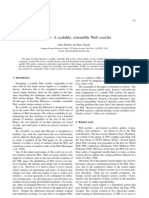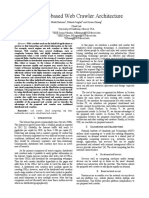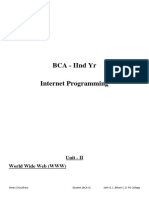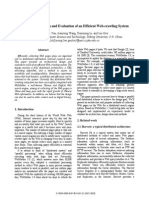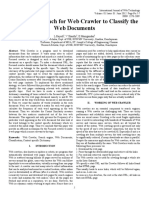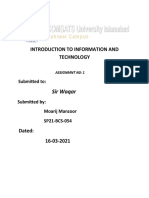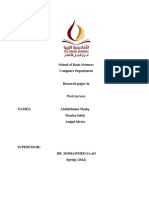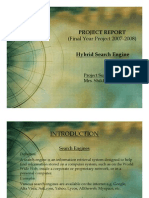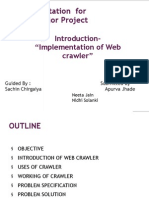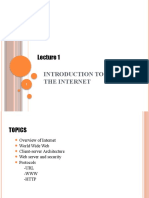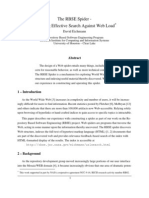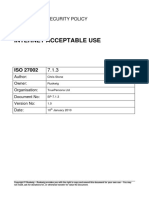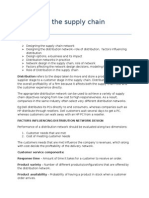Web Technology, Unit 1
Web Technology, Unit 1
Uploaded by
Bipin SinghCopyright:
Available Formats
Web Technology, Unit 1
Web Technology, Unit 1
Uploaded by
Bipin SinghOriginal Title
Copyright
Available Formats
Share this document
Did you find this document useful?
Is this content inappropriate?
Copyright:
Available Formats
Web Technology, Unit 1
Web Technology, Unit 1
Uploaded by
Bipin SinghCopyright:
Available Formats
Web Technology
MCA-124
Rajkumar
Research Scholar,
I.T.C.A.
MMMUT, Gorakhpur
September 14, 2020
Rajkumar Research Scholar, I.T.C.A. Web Technology MCA-124
Outline
Unit-I
I World Wide Web X
I WWW Architecture X
I Web Search Engine X
I Web Crawling X
I Web Indexing X
I Web Mining
Rajkumar Research Scholar, I.T.C.A. Web Technology MCA-124
References Books
1. Web Technologies, 1/e -Uttam K. Roy ,Oxford University Press, USA
2. Web Technology: Theory and Practice -M. Srinivasan, Pearson Education India,
3. Deitel, Deitel and Nieto, Internet and Worldwide Web -How to Program, 5th
Edition, PHI, 2011.
4. Developing Web Application-Second Editon -Ralph Moseley & M. T. Savaliya,
Wiley
5. Web Programming Step by Step, Stepp/Miller/Kirst, 2nd edition, 2009
Rajkumar Research Scholar, I.T.C.A. Web Technology MCA-124
World Wide Web
1. World Wide Web, which is also known as a Web, is a collection of websites or
web pages stored in web servers and connected to local computers through the
internet.
2. websites contain text pages, digital images, audios, videos, etc.
3. A web page is given an online address called a Uniform Resource Locator (URL).
A particular collection of web pages that belong to a specific URL is called a
website, e.g., www.facebook.com, www.google.com, etc.
Rajkumar Research Scholar, I.T.C.A. Web Technology MCA-124
Difference between World Wide Web and Internet
Figure: 1 World Wide Web and Internet
Rajkumar Research Scholar, I.T.C.A. Web Technology MCA-124
How the World Wide Web Works?
WWW is a collection of websites connected to the internet so that people can search
and share information. Now, let us understand how it works!
Figure: 2 World Wide Web Working process
Rajkumar Research Scholar, I.T.C.A. Web Technology MCA-124
How the World Wide Web Works?
1. The Web works as per the internet’s basic client-server format as shown in the
following image.
2. The servers store and transfer web pages or information to user’s computers on
the network when requested by the users.
3. A web server is a software program which serves the web pages requested by web
users using a browser.
4. The computer of a user who requests documents from a server is known as a
client.
Rajkumar Research Scholar, I.T.C.A. Web Technology MCA-124
The moment you open the browser and type a URL in the address bar or search some-
thing on Google, the WWW starts working. There are three main technologies involved
in transferring information (web pages) from servers to clients (computers of users).
These technologies include Hypertext Markup Language (HTML), Hypertext Transfer
Protocol (HTTP) and Web browsers.
Figure: 3 World Wide Web Working process
Rajkumar Research Scholar, I.T.C.A. Web Technology MCA-124
WWW Architecture
WWW architecture is divided into several layers as shown in the following diagram:
Figure: 4 World Wide Web Architecture
Rajkumar Research Scholar, I.T.C.A. Web Technology MCA-124
WWW Architecture I
Identifiers and Character Set
Uniform Resource Identifier (URI) is used to uniquely identify resources on the web
and UNICODE makes it possible to built web pages that can be read and write in
human languages.
Syntax
XML (Extensible Markup Language) helps to define common syntax in semantic web.
Data Interchange
Resource Description Framework (RDF) framework helps in defining core
representation of data for web. RDF represents data about resource in graph form.
Taxonomies
RDF Schema (RDFS) allows more standardized description of taxonomies and other
ontological constructs.
Rajkumar Research Scholar, I.T.C.A. Web Technology MCA-124
WWW Architecture II
Ontologies Web Ontology Language (OWL) offers more constructs over RDFS. It
comes in following three versions:
1. OWL Lite for taxonomies and simple constraints.
2. OWL DL for full description logic support.
3. OWL for more syntactic freedom of RDF.
Rules RIF and SWRL offers rules beyond the constructs that are available from RDFs
and OWL. Simple Protocol and RDF Query Language (SPARQL) is SQL like language
used for querying RDF data and OWL Ontologies.
Proof All semantic and rules that are executed at layers below Proof and their result
will be used to prove deductions.
Cryptography Cryptography means such as digital signature for verification of the
origin of sources is used.
User Interface and Applications On the top of layer User interface and Applications
layer is built for user interaction.
Rajkumar Research Scholar, I.T.C.A. Web Technology MCA-124
WWW Architecture III
How it work
WWW works on client- server approach. Following steps explains how the web works:
1. User enters the URL (say, http://www.xyz.com) of the web page in the address
bar of web browser.
2. Then browser requests the Domain Name Server for the IP address corresponding
to www.xyz.com.
3. After receiving IP address, browser sends the request for web page to the web
server using HTTP protocol which specifies the way the browser and web server
communicates.
4. Then web server receives request using HTTP protocol and checks its search for
the requested web page. If found it returns it back to the web browser and close
the HTTP connection.
5. Now the web browser receives the web page, It interprets it and display the
contents of web page in web browser’s window.
Rajkumar Research Scholar, I.T.C.A. Web Technology MCA-124
WWW Architecture IV
Figure: 5 World Wide Web Architecture
Rajkumar Research Scholar, I.T.C.A. Web Technology MCA-124
Web Search Engine
Search engines are answer machines. They exist to discover, understand, and organize
the internet’s content in order to offer the most relevant results.
How do search engines work?
Search engines have three primary functions:
I Crawl: Scour the Internet for content, looking over the code/content for each
URL they find.
I Index: Store and organize the content found during the crawling process. Once a
page is in the index, it’s in the running to be displayed as a result to relevant
queries.
I Rank: Provide the pieces of content that will best answer a searcher’s query,
which means that results are ordered by most relevant to least relevant.
Rajkumar Research Scholar, I.T.C.A. Web Technology MCA-124
Web Crawling
A key motivation for designing Web crawlers has been to retrieve Web pages and add
their representations to a local repository.
I What is the “Web Crawling
I What are the uses of Web Crawling
I How API are used
-A Web crawler (also known as a Web spider, Web robot, or—especially in the FOAF
community—Web scutter) is a program or automated script that browses the World
Wide Web in a
-methodical
-automated manner
-Other less frequently used names for Web crawlers are ants, automatic indexers, bots,
and worms.
Rajkumar Research Scholar, I.T.C.A. Web Technology MCA-124
What the Crawlers are...
Crawlers are computer programs that roam the Web with the goal of automating
specific tasks related to the Web.The role of Crawlers is to collect Web Content.
Basic crawler operation
1. Begin with known “seed” pages
2. Fetch and parse them
3. Extract URLs they point to
4. Place the extracted URLs on a Queue
5. Fetch each URL on the queue and repeat URLs on a Queue
Rajkumar Research Scholar, I.T.C.A. Web Technology MCA-124
Several Types of Crawlers
I Batch Crawlers- Crawl a snapshot of their crawl space, until reaching a certain
size or time limit.
I Incremental Crawlers- Continuously crawl their crawl space, revisiting URL to
ensure freshness.
I Focused Crawlers- Attempt to crawl pages pertaining to some topic/theme, while
minimizing number of off topic pages that are collected.
I ...
The challenges of “Web Crawling”
There are three important characteristics of the Web that make crawling it very
difficult:
1. Its large volume
2. fast rate of change
3. Dynamic page generation
Rajkumar Research Scholar, I.T.C.A. Web Technology MCA-124
The working of a web crawler is as follows...
I Initializing the seed URL or URLs.
I Adding it to the frontier.
I Selecting the URL from the frontier.
I Fetching the web-page corresponding to that URLs.
I Parsing the retrieved page to extract the URLs.
I Adding all the unvisited links to the list of URL i.e. into the frontier.
I Again start with step 2 and repeat till the frontier is empty.
Rajkumar Research Scholar, I.T.C.A. Web Technology MCA-124
Architecture of a Web Crawler
Architecture of a web crawler Figure shows the generalized architecture of web crawler.
It has three main components:a frontier which stores the list of URL’s to visit, Page
Downloader which download pages from WWW andWeb Repository receives web pages
from a crawler and stores it in the database.
Figure: 6 Web Crawling Working process
Rajkumar Research Scholar, I.T.C.A. Web Technology MCA-124
Flow of web crawler
Figure: 7 Flow of web crawler
Rajkumar Research Scholar, I.T.C.A. Web Technology MCA-124
Search Engine Index
Search engine Index
Search engines process and store information they find in an index, a huge database of
all the content they’ve discovered and deem good enough to serve up to searchers.
Search engine Ranking
When someone performs a search, search engines scour their index for highly relevant
content and then orders that content in the hopes of solving the searcher’s query.
This ordering of search results by relevance is known as ranking.
Rajkumar Research Scholar, I.T.C.A. Web Technology MCA-124
Web Mining
Web Mining is the process of Data Mining techniques to automatically discover and
extract information from Web documents and services.
The main purpose of web mining is discovering useful information from the World-Wide
Web and its usage patterns.
Applications of Web Mining:
I Web mining helps to improve the power of web search engine by classifying the
web documents and identifying the web pages.
I It is used for Web Searching e.g., Google, Yahoo etc and Vertical Searching e.g.,
FatLens, Become etc.
I Web mining is used to predict user behavior.
I Web mining is very useful of a particular Website and e-service e.g., landing page
optimization.
Rajkumar Research Scholar, I.T.C.A. Web Technology MCA-124
Web Mining I
Web mining can be broadly divided into three different types of techniques of mining:
1. Web Content Mining
2. Web Structure Mining
3. Web Usage Mining
These are explained as following below.
Rajkumar Research Scholar, I.T.C.A. Web Technology MCA-124
Web Content Mining:
I Web content mining is the application of extracting useful information from the
content of the web documents. Web content consist of several types of data –
text, image, audio, video etc.
I The Content data is the group of facts that a web page is designed. It can
provide effective and interesting patterns about user needs.
I The Text documents are related to text mining, machine learning and natural
language processing. This mining is also known as text mining.
I This type of mining performs scanning and mining of the text, images and groups
of web pages according to the content of the input.
Rajkumar Research Scholar, I.T.C.A. Web Technology MCA-124
Web Structure Mining:
I Web structure mining is the application of discovering structure information from
the web. The structure of the web graph consists of web pages as nodes, and
hyperlinks as edges connecting related pages.
I Structure mining basically shows the structured summary of a particular website.
It identifies relationship between web pages linked by information or direct link
connection.
I To determine the connection between two commercial websites, Web structure
mining can be very useful.
Rajkumar Research Scholar, I.T.C.A. Web Technology MCA-124
Web Usage Mining:
I Web usage mining is the application of identifying or discovering interesting usage
patterns from large data sets.
I These patterns enable you to understand the user behaviors or something like
that. In web usage mining, user access data on the web and collect data in form
of logs.
I So, Web usage mining is also called log mining.
Rajkumar Research Scholar, I.T.C.A. Web Technology MCA-124
References
I Web Enabled Commercial Application Development Using HTML, DHTML, Java
Script, Perl & CGI -Ivan Bayross (BPB Publication), 2005.
I Internet and WebTechnologies, RAJ KAMAL, Tata McGraw Hill.
I Java Server Pages–Hans Bergsten, SPD O’Reilly.
I www.w3c.org
Rajkumar Research Scholar, I.T.C.A. Web Technology MCA-124
Thank You for Your Attention!
For any query contact me:
rajkumargaur[AT]mmmut.ac.in
8299722827
Rajkumar Research Scholar, I.T.C.A. Web Technology MCA-124
You might also like
- RastaDocument7 pagesRastawhatever100% (1)
- Erformance Valuation EB Rawler: P E O W CDocument34 pagesErformance Valuation EB Rawler: P E O W CAli NawazNo ratings yet
- 13 Building Search Engine Using Machine Learning TechniqueDocument4 pages13 Building Search Engine Using Machine Learning TechniqueVamsiNo ratings yet
- Extended Curlcrawler: A Focused and Path-Oriented Framework For Crawling The Web With ThumbDocument9 pagesExtended Curlcrawler: A Focused and Path-Oriented Framework For Crawling The Web With Thumbsurendiran123No ratings yet
- Online Banking Loan Services: International Journal of Application or Innovation in Engineering & Management (IJAIEM)Document4 pagesOnline Banking Loan Services: International Journal of Application or Innovation in Engineering & Management (IJAIEM)International Journal of Application or Innovation in Engineering & ManagementNo ratings yet
- Mercator: A Scalable, Extensible Web Crawler: Allan Heydon Marc Najork Compaq Systems Research CenterDocument14 pagesMercator: A Scalable, Extensible Web Crawler: Allan Heydon Marc Najork Compaq Systems Research CenterEmma AlarconNo ratings yet
- Brief Introduction On Working of Web Crawler: Rishika Gour Prof. Neeranjan ChitareDocument4 pagesBrief Introduction On Working of Web Crawler: Rishika Gour Prof. Neeranjan ChitareEditor IJRITCCNo ratings yet
- Web Crawler A ReviewDocument6 pagesWeb Crawler A ReviewMouhammad SryhiniNo ratings yet
- Search Engine With Web CrawlerDocument23 pagesSearch Engine With Web CrawlerNithinNo ratings yet
- A Two Stage Crawler On Web Search Using Site Ranker For Adaptive LearningDocument4 pagesA Two Stage Crawler On Web Search Using Site Ranker For Adaptive LearningKumarecitNo ratings yet
- World Wide WebDocument8 pagesWorld Wide WebJoseph MungaiNo ratings yet
- Web Crawler A SurveyDocument3 pagesWeb Crawler A SurveyInternational Journal of Innovative Science and Research TechnologyNo ratings yet
- CS8080 Irt Unit 4 23 24Document36 pagesCS8080 Irt Unit 4 23 24swarnaas2124No ratings yet
- Mercator: A Scalable, Extensible Web Crawler: Compaq Systems Research Center, 130 Lytton Avenue, Palo Alto, CA 94301, USADocument11 pagesMercator: A Scalable, Extensible Web Crawler: Compaq Systems Research Center, 130 Lytton Avenue, Palo Alto, CA 94301, USALeena MendirattaNo ratings yet
- Study of Web Crawler and Its Different TypesDocument8 pagesStudy of Web Crawler and Its Different TypesAlishbah Khan NiaziiNo ratings yet
- Explores The Ways of Usage of Web Crawler in Mobile SystemsDocument5 pagesExplores The Ways of Usage of Web Crawler in Mobile SystemsInternational Journal of Application or Innovation in Engineering & ManagementNo ratings yet
- Web Scraping - Unit 1Document31 pagesWeb Scraping - Unit 1MANOHAR SIVVALA 20111632100% (1)
- Website ArchitectureDocument7 pagesWebsite ArchitectureBariq AttallahNo ratings yet
- Cosc405 AssignmentDocument7 pagesCosc405 Assignmentthe messiahNo ratings yet
- Comparative Study On Semantic Search EnginesDocument9 pagesComparative Study On Semantic Search EnginesNang NangNo ratings yet
- CSE 20CS01P U2 S1 Sy1Document4 pagesCSE 20CS01P U2 S1 Sy1manjunath.ok1No ratings yet
- HeleenDocument7 pagesHeleenBariq AttallahNo ratings yet
- Full Stack - Unit 1Document15 pagesFull Stack - Unit 1saitamaakaopmanNo ratings yet
- 21jul201512071432 DAIWAT A VYAS 1-6Document6 pages21jul201512071432 DAIWAT A VYAS 1-6Yesenia GonzalezNo ratings yet
- Title Search Engine: Submitted in Partial Fulfillment For The Award of DegreeDocument40 pagesTitle Search Engine: Submitted in Partial Fulfillment For The Award of DegreevineetkanwatNo ratings yet
- Bahrami Et Al. A Cloud-Based Web Crawler Architecture Cloud Lab UcmDocument8 pagesBahrami Et Al. A Cloud-Based Web Crawler Architecture Cloud Lab UcmManoj Kumar MauryaNo ratings yet
- Unit 2 IpDocument8 pagesUnit 2 Ipuniqueguy824No ratings yet
- Online Banking Loan Services: International Journal of Application or Innovation in Engineering & Management (IJAIEM)Document5 pagesOnline Banking Loan Services: International Journal of Application or Innovation in Engineering & Management (IJAIEM)International Journal of Application or Innovation in Engineering & ManagementNo ratings yet
- An Effective Implementation of Web Crawling Technology To Retrieve Data From The World Wide Web WWW - 220200226 36108 8o75vt With Cover Page v2Document6 pagesAn Effective Implementation of Web Crawling Technology To Retrieve Data From The World Wide Web WWW - 220200226 36108 8o75vt With Cover Page v2KathleenNo ratings yet
- Web DevelopmentDocument61 pagesWeb DevelopmentHot Beauty LiveNo ratings yet
- Architectural Design and Evaluation of An Efficient Web-Crawling SystemDocument8 pagesArchitectural Design and Evaluation of An Efficient Web-Crawling SystemkhadafishahNo ratings yet
- A Novel Approach For Web Crawler To Classify The Web DocumentsDocument3 pagesA Novel Approach For Web Crawler To Classify The Web Documentsijbui iirNo ratings yet
- Web Crawler & Scraper Design and ImplementationDocument9 pagesWeb Crawler & Scraper Design and Implementationkassila100% (1)
- Architecture of Web Server - 023607-1Document6 pagesArchitecture of Web Server - 023607-1cc76747321No ratings yet
- Sir Waqar: Introduction To Information and TechnologyDocument5 pagesSir Waqar: Introduction To Information and TechnologySp21-Bcs-054 Muhammad MoarijNo ratings yet
- Web Server ProjectDocument16 pagesWeb Server Projectمعتز العجيليNo ratings yet
- Web2py IntroDocument9 pagesWeb2py Introalaa abu madiNo ratings yet
- Crahid: A New Technique For Web Crawling in Multimedia Web SitesDocument6 pagesCrahid: A New Technique For Web Crawling in Multimedia Web SitesInternational Journal of computational Engineering research (IJCER)No ratings yet
- Case Study WWWDocument23 pagesCase Study WWWrabindhakal71.rdNo ratings yet
- AWP Module 1Document25 pagesAWP Module 1nayakspradip2000No ratings yet
- WebpageDocument23 pagesWebpageSurya MaharaNo ratings yet
- Project ReportDocument22 pagesProject ReportMumin KhanNo ratings yet
- M1 Part3Document18 pagesM1 Part3AmanNo ratings yet
- MajorDocument14 pagesMajorNidhi SolankiNo ratings yet
- (IJETA-V11I3P34) :santosh Kumar, Nitin Kumar, Shashank Ranjan, Akhilesh KumarDocument6 pages(IJETA-V11I3P34) :santosh Kumar, Nitin Kumar, Shashank Ranjan, Akhilesh KumareditorijetaNo ratings yet
- Wit Lecture Notes by RaginiDocument239 pagesWit Lecture Notes by Raginitezom techeNo ratings yet
- Lab Introduce WebDocument23 pagesLab Introduce Webshruthig29111988No ratings yet
- EDS WebCrawlerArchitectureDocument3 pagesEDS WebCrawlerArchitectureAnubhav PareekNo ratings yet
- Cse3024 Web-Mining Eth 1.1 47 Cse3024 PDFDocument12 pagesCse3024 Web-Mining Eth 1.1 47 Cse3024 PDFAyush SoodNo ratings yet
- CH1&2Document151 pagesCH1&2Abenezer MekonnenNo ratings yet
- Analysis of Web Mining Types and WeblogsDocument4 pagesAnalysis of Web Mining Types and WeblogsVeera RagavanNo ratings yet
- The RBSE Spider - Balancing Effective Search Against Web LoadDocument8 pagesThe RBSE Spider - Balancing Effective Search Against Web LoadpostscriptNo ratings yet
- Web ScrapingDocument11 pagesWeb ScrapingSantosh KandariNo ratings yet
- Computer Project PDFDocument23 pagesComputer Project PDFSurya MaharaNo ratings yet
- Crawler and URL Retrieving & QueuingDocument5 pagesCrawler and URL Retrieving & QueuingArnav GudduNo ratings yet
- Seminar ReportDocument44 pagesSeminar ReportAkhil Srivastava100% (4)
- Web Scraping With Python and Selenium: Sarah Fatima, Shaik Luqmaan Nuha Abdul RasheedDocument5 pagesWeb Scraping With Python and Selenium: Sarah Fatima, Shaik Luqmaan Nuha Abdul RasheedVanessa DouradoNo ratings yet
- Web Applications using JSP (Java Server Page): Develop a fully functional web applicationFrom EverandWeb Applications using JSP (Java Server Page): Develop a fully functional web applicationNo ratings yet
- React and React Native: Build cross-platform JavaScript apps with native power for mobile, web and desktopFrom EverandReact and React Native: Build cross-platform JavaScript apps with native power for mobile, web and desktopNo ratings yet
- Static NAT in SRXDocument4 pagesStatic NAT in SRXSon Tran Hong NamNo ratings yet
- Host Driver Logs CurrentDocument2,229 pagesHost Driver Logs CurrentХабибNo ratings yet
- Get Only NEW Emails Imaplib and PythonDocument8 pagesGet Only NEW Emails Imaplib and PythonParamesh SandeepNo ratings yet
- 2021 IJSOI Pooja VikasDocument16 pages2021 IJSOI Pooja Vikasdevdgp2003No ratings yet
- Forcepoint Appliances Getting Started Guide: V Series, X Series, & Virtual AppliancesDocument70 pagesForcepoint Appliances Getting Started Guide: V Series, X Series, & Virtual AppliancesRaul CastroNo ratings yet
- Pest Analysis MTNLDocument9 pagesPest Analysis MTNLOltre777100% (1)
- Packet Tracer Simulation - TCP and UDP Communications: Name: Saad Kabir Uddin Matric No: A19EC4056 Section: 08Document6 pagesPacket Tracer Simulation - TCP and UDP Communications: Name: Saad Kabir Uddin Matric No: A19EC4056 Section: 08Saad Kabir ProttoyNo ratings yet
- PCS7 in OG enDocument76 pagesPCS7 in OG endilo001No ratings yet
- Hytera Smart Dispatch PortsDocument3 pagesHytera Smart Dispatch Portstanajm60No ratings yet
- Internet Acceptable Use: Information Security PolicyDocument8 pagesInternet Acceptable Use: Information Security PolicyIgun ZillaNo ratings yet
- Sip Connection DebugDocument5 pagesSip Connection DebugtheajkumarNo ratings yet
- Infoblox Ebook Top Ten Dns AttacksDocument14 pagesInfoblox Ebook Top Ten Dns AttacksmegaNo ratings yet
- Moocs PPT 5th SemDocument18 pagesMoocs PPT 5th SemMohit KharayatNo ratings yet
- GIFT Application Manual.: Fill in With YourDocument5 pagesGIFT Application Manual.: Fill in With YourBogdan DaisaNo ratings yet
- Mcqs 1Document40 pagesMcqs 1Ali Nawaz AyubiNo ratings yet
- Judges, Cyberspace and Social Media by Judge J.C. GibsonDocument30 pagesJudges, Cyberspace and Social Media by Judge J.C. GibsonHornbook RuleNo ratings yet
- BMCRF SurveyMonkeyDocument6 pagesBMCRF SurveyMonkeypbhavanikdNo ratings yet
- 3 - NIC SettingsDocument5 pages3 - NIC SettingsLucas MeirelesNo ratings yet
- Outreach Strategy1 PDFDocument73 pagesOutreach Strategy1 PDFwowjoomlaNo ratings yet
- WT Final ProjectDocument16 pagesWT Final ProjectThakur singh nagarwalNo ratings yet
- Designing The Supply Chain NetworkDocument10 pagesDesigning The Supply Chain NetworkZahraShahid100% (2)
- Teacher's Edition Realidades 2: April 2020Document2 pagesTeacher's Edition Realidades 2: April 2020Wiliam Silva CarrilloNo ratings yet
- Instagarm AccountDocument2 pagesInstagarm Accountbadass.bazoookaNo ratings yet
- Pexip Infinity Cisco VCS Deployment Guide V30.aDocument14 pagesPexip Infinity Cisco VCS Deployment Guide V30.apjdinisNo ratings yet
- API Security Best PracticesDocument4 pagesAPI Security Best PracticesJknoxvilNo ratings yet
- Source Code Form and Thanku Page EmailDocument11 pagesSource Code Form and Thanku Page EmailAnkit JainNo ratings yet
- S5310-EI Series SwitchesDocument10 pagesS5310-EI Series SwitchesHarishNo ratings yet
- Chapter 2 E-CommerceDocument1 pageChapter 2 E-CommerceUday AdhikariNo ratings yet
- Essay #2 Social Media-4Document6 pagesEssay #2 Social Media-4mariNo ratings yet













